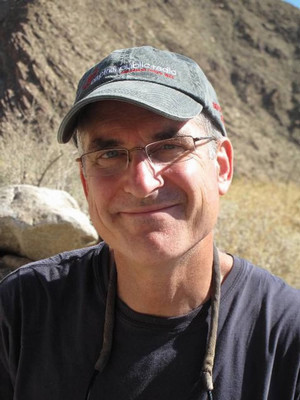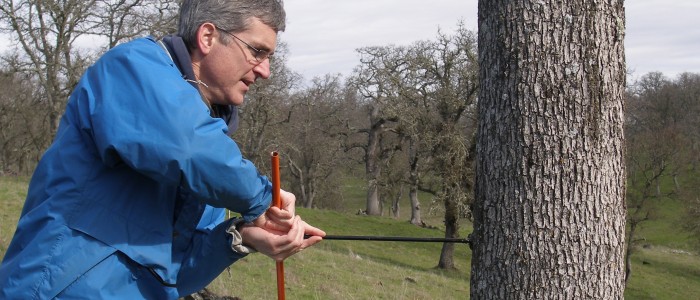Jim Baxter, Professor of Biological Sciences
Welcome to my faculty webpage!
Contact Information

Jim Baxter
Professor
- M 12-1 pm, W 9-10 am, TH 12-1 pm,
- or by appointment
Courses
Methods in Ecology, Evolution and Conservation (BIO 221B) is a graduate level course that introduces students to a variety of research methods in ecology, evolution and conservation biology. The course emphasizes field and laboratory techniques and focuses on a variety of taxa in a range of local ecosystems. Students work with several faculty conducting research projects. Topics include developing hypotheses, experimental design, study implementation, and statistical analyses. Students are expected to present findings in oral and written form. Two three hour laboratory periods.
About
I am a plant ecologist with expertise in community dynamics, plant-mycorrhizal interactions, biodiversity-functioning, and human impacts on ecosystems. Over the past 10 years, my lab focused on the ecology of plant-mycorrhizal interactions and the role of common mycorrhizal networks in plant communities.
I teach courses in ecology, plant ecology, quantitative methods, and introductory biology. I am also director of the California Environmental Legacy Project, an educational media project about environmental change intended for public and professional audiences.
Research
I no longer maintain an active research lab and am not taking on new students.
My former research explored plant-mycorrhizal interactions, with a focus on how common mycorrhizal networks influenced the structure and functioning of plant communities.
Other research in my lab examined restoration of native California grasslands, factors influencing oak regeneration, effects of fire regimes on forest community structure, the impact of earthen dams on invasive species, and the role of heavy metals as plant anti-herbivore defenses.
Here are some of the former projects my students and I were involved in:
Common mycorrhizal networks
Mycorrhizal fungi play an important role in facilitating water and nutrient uptake to plants. Common mycorrhizal networks (CMN) are associations of mycorrhizal species connecting multiple plant hosts. Although multiple nutrients (e.g., C, N) are known to transfer among plant hosts connected to CMNs, less is known about the role of these networks in water transfer, reduction of drought stress, and transmission of herbivore defense cues. Former graduate students, Ian Mounts and Dan Lenz and examined these questions in their thesis research. Undergraduate student, Makenzie Pierce, also investigated the role of herbivore defense cues.
Restoration and invasive species
Former students in my lab have studied different aspects of restoration and the impacts of invasive species. For example, Carol Fonseca studied intraspecific patterns of divergence and variation in early stages of development in Elymus glaucus, a California native bunchgrass. Christian Commander examined the effect of earthen dams on the distribution and abundance of Arundo donax (giant reed), an invasive plant species that colonizes freshwater systems and riparian corridors in the southern United States from Maryland to California.
Oak regeneration
Blue oak (Quercus douglasii) woodlands are a dominant plant community in the foothills of the Coastal Range and Sierra Nevada mountains. However, blue oak is experiencing poor regeneration throughout its range. It is unclear which factor or factors are causing this decline. A former student in my lab, Erika Teach, studied the impact of soil compaction by large grazers on germination and seedling growth of blue oak at the Sierra Foothill Research and Extension Center (SFREC) located in Yuba County, California. Another study, conducted by former student Pam Lindholm, examined the age structure and recruitment of blue oak at Deer Creek Hills Preserve, Sacramento Co., California.

Science Education
The California Environmental Legacy Project is a new kind of educational media project. By combining artful storytelling and state-of-the-art digital media, the Legacy Project seeks to raise awareness and understanding about our changing natural environment. It brings together distinguished scientists, educators and media producers to create inspirational stories about California’s changing natural environment.
Legacy Project productions include Becoming California, a 2-hour documentary program on environmental change in California, a set of regional films produced for five park visitor centers around the state, and an interactive website with streaming video and social networking capabilities.
Narrated by Jane Fonda and with original music by Pat Metheny, Legacy Project productions will be the first to tell the grand story of environmental change in California, from colliding tectonic plates, to the community of life, human exploitation, coexistence and more.
People
FORMER GRADUATE STUDENTS
Taylor Akers – MS Degree: Spring 2024
Thesis: Low-intensity prescribed fire and mechanical thinning alter the composition of soil fungi in a mixed coniferous forest of the western Sierra Nevada.
Kalen Edwards – MS Degree: Spring 2024
Thesis: The effect of fire and mechanical thinning on soil exoenzyme activity in mixed coniferous forests of the western Sierra Nevada.
Dan Lenz – MS Degree: Fall 2020
Thesis: Propagation of anti-herbivore defense cues in a common mycorrhizal network
Ian Mounts – MS Degree: Spring 2019
Thesis: The role of common mycorrhizal networks in ameliorating drought stress in Pseudotsuga menziesii
Erika Teach – MS Degree: Fall 2014
Thesis: Effects of soil compaction on emergence and growth of Quercus douglasii: implications for seedling recruitment
Christian Commander – MS Degree: Fall 2013
Thesis: The influence of dams on the abundance of Arundo donax (giant reed) in riparian corridors
Carolina Fonseca – MS Degree: Spring 2013
Thesis: Patterns of population differentiation in early traits of development in Elymus glaucus.
Beth Lesar – MS Degree: Spring 2009
Thesis: Influence of historical fire frequency on forest cover and stand structure in northeastern California
Andrew Griffiths – MS Degree: Spring 2007
Thesis: Heavy metal accumulation in MacDonald’s rock cress (Arabis macdonaldiana) defends against herbivory: a field experiment
Pamela Conavay – MS Degree: Spring 2007
Thesis: Population age structure and recruitment of blue oak (Quercus douglasii) at Deer Creek Hills Preserve, Sacramento County, California.
Justin Cutler – MS Degree: Fall 2006
Thesis: Accuracy assessment of high resolution multispectral satellite imagery for remote sensing identification of wetlands and classification of vernal pools in eastern Sacramento County, California.
FORMER UNDERGRADUATE STUDENTS
Makenzie Pierce – 2021
Makenzie examined whether propagation of anti-herbivore defense cues through a common mycorrhizal network can affect herbivore performance
Kathryn Mercier – 2021
Kathryn sought to examine whether plants receiving anti-herbivore defense cues through a common mycorrhizal network experience fitness costs
Chris Fernandez – 2005
Chris investigated whether there is a community-level association between the shrub Toyon (Heteromeles arbutifolia) and several oak species near Sweetwater Creek, El Dorado County.
Eddy Morgan – 2004
Eddy compared the effect of stormwater effluent on algal species abundance and richness in the American River, Sacramento County.
Publications
Baxter, J. W., J. Fraser, J. White, and N. Ardalan. Media message and tool preferences of environmental educators. Journal of Environmental Education. Submitted.
Fraser, J., J. W. Baxter, J. White, R. Gupta, and V. Yocco. 2014. Conversion aversion: environmental learning and PBS viewer preferences. Journal of Mass Communication and Journalism 4: 225. doi:10.4172/2165-7912.1000225.
Fonseca, C.*, E. Epseland, and J. W. Baxter. 2014. Patterns of population differentiation in germination and seedling growth in Elymus glaucus: implications for restoration practice. Ecological Restoration 34: 388-395.
Baxter, J. W. and J. Dighton. 2005. Phosphorus source alters host plant response to ectomycorrhizal diversity. Mycorrhiza 15: 513-523.
Baxter, J. W. and J. Dighton. 2005. Diversity-functioning relationships in ectomycorrhizal fungal communities. In: The fungal community: its organization and role in the ecosystem. J. Dighton, P. Oudemans, and J. White, Editors. Marcel Dekker, New York, NY.
Baxter, J. W., S. T. A. Pickett, J. Dighton and M. M. Carreiro. 2002. Nitrogen and phosphorus availability in oak forest stands exposed to contrasting anthropogenic impacts. Soil Biology and Biochemistry. 34: 623-633.
Baxter, J. W. and J. Dighton. 2001. Ectomycorrhizal diversity alters the growth of gray birch (Betula populifolia Marshall) seedlings in experimental host-symbiont culture conditions. New Phytologist 152: 139-149.
Lovett, G. M., M. M. Traynor, R. V. Pouyat, M. M. Carreiro, W. Zhu and J. W. Baxter. 2000. Atmospheric deposition to oak forests along an urban-rural gradient. Environmental Science and Technology. 34: 4294-4300.
Baxter, J. W., S. T. A. Pickett, M. M. Carreiro and J. Dighton. 1999. Ectomycorrhizal diversity and community structure in oak forest stands exposed to contrasting anthropogenic impacts. Canadian Journal of Botany 77: 771-782.
Baxter, J. W. and V. T. Parker. 1999. Canopy gaps and topography structure a northern coastal scrub community on California coastal bluffs. Madroño 46: 69-79.
Breitberg, D. L., J. W. Baxter, C. Hatfield, R. W. Howarth, C. G. Jones, G. M. Lovett and C. Wigand. 1998. Understanding the effects of multiple stressors: ideas and challenges. In: M. L. Pace and P. M. Groffman (eds.). Successes, Limitations and Frontiers in Ecosystem Science. Springer-Verlag, New York, New York, USA.
Manuscripts in preparation
Akers, T. F.* and J. W.Baxter. Prescribed fire and mechanical thinning alter the composition of soil fungi in a mixed conifer forest of the Sierra Nevada. Target: Forest Ecology and Management.
Commander, C.* and J. W. Baxter. The influence of earthen dams on the abundance and distribution of Arundo donax (giant reed) along riparian corridors in California. Target: Biological Invasions.
Lindholm, P. E.* and J. W. Baxter. Age structure and recruitment of blue oak (Quercus douglasii) at Deer Creek Hills Preserve, Sacramento County, California. Target: Madroño.
Baxter, J. W. and A. Griffiths*. Heavy metal accumulation in McDonald’s rock cress (Arabis macdonaldiana) defends against herbivory. Target: American Journal of Botany.
*Graduate Student